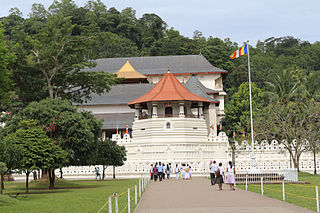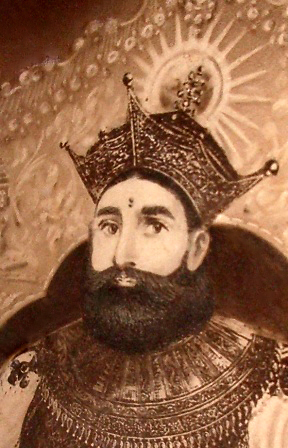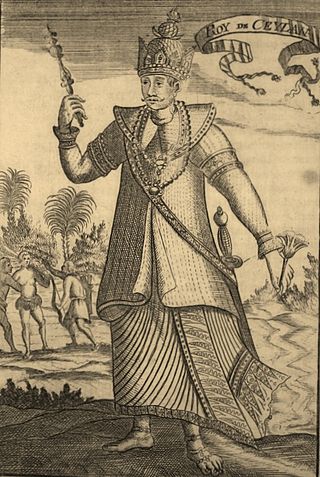Related Research Articles

Kandy is a major city in located in the Central Province of Sri Lanka. It was the last capital of the Sinhalese monarchy from 1469 to 1818, under the Kingdom of Kandy. The city is situated in the midst of hills in the Kandy plateau, which crosses an area of tropical plantations, mainly tea. Kandy is both an administrative and religious city and the capital of the Central Province. Kandy is the home of the Temple of the Tooth Relic, one of the most sacred places of worship in the Buddhist world. It was declared a World Heritage Site by UNESCO in 1988. Historically the local Buddhist rulers resisted Portuguese, Dutch, and British colonial expansion and occupation.

The Kandyan Wars refers generally to the period of warfare between the British colonial forces and the Kingdom of Kandy, on the island of what is now Sri Lanka, between 1796 and 1818. More specifically it is used to describe the expeditionary campaigns of the British Army in the Kingdom of Kandy in 1803 and 1815.
The SiamNikaya is a monastic order within Sri Lankan Buddhism, founded by Upali Thera of Siyam, on the initiatives taken by Weliwita Sri Saranankara thera to revive Buddhism in Sri Lanka in the mid 18th century. At the beginning it was located predominantly around the city of Kandy but now has spread to the other parts of the country as well. It is named as 'Siyam' because it was originated within Thailand. The Siyam Nikaya has two major divisions and five other divisions within these two major units. The Malwatta and Asgiriya chapters have two separate Maha Nayaka theros or chief monks.
Govigama is a Sinhalese caste found in Sri Lanka. They form approximately half of the Sinhalese population and are traditionally involved in agriculture. The term Govigama became popular during the last period of the Sinhalese Kingdom of Kandy. Its members have dominated and influenced national politics and Sinhalese Buddhism.

Sri Vikrama Rajasinha, born Kannasamy, was the last of four kings to rule the Kingdom of Kandy in Sri Lanka. Being crowned king in 1798 with the backing of Pilamathalawe Adikaram, his capture by the British in 1815 effectively concluded the 2,300-year Sinhalese monarchy on the island. The Nayak Kings were of Telugu origin and practiced Shaivite Hinduism and were patrons of Theravada Buddhism. The Nayak rulers played a huge role in reviving Buddhism in the island. They spoke Telugu and Tamil, and used Tamil as the court language in Kandy alongside Sinhala.

The Nayaks of Kandy were the rulers of the Kingdom of Kandy between 1739 and 1815, and the last dynasty to rule on the island. The term Nayak is derived from the Sanskrit word Nāyaka. Their rise to power came about as a result of the death of Vira Narendrasinha, who left no legitimate heir- the throne passed to his brother-in-law, who was crowned as Sri Vijaya Rajasinha in 1739. They were of Telugu Balija origin, spoke Sinhala, Telugu and Tamil, and used both Sinhala and Tamil as their court languages. They are also credited for building various Vishnu temples in Sri Lanka dedicated to their clan deity Vishnu, known as Upulvan in Sinhala. A prominent one of them was the Kandy Vishnu Temple established at their capital Kandy. A cadet branch of the Madurai Nayak dynasty, the Kandyan Nayaks were related to the Thanjavur Nayaks as well. Both Madurai and Thanjavur nayaks belonged to Kamma caste.
Bangaru Thirumala Nayaka, also known as Bangaru Tirumala and Vangaru Thirumala, was a member of Madurai Nayak royal family and Governor/Commander of the Madurai Nayak King Vijaya Ranga Chokkanatha (1704–1731). His son, a young boy was adopted and crowned to the Madurai Throne, with the queen Meenakshi as queen regent, when the Madurai king died without heir. Strife between Bangaru Thirumala and queen Meenakshi would later erupt into many battles leading to the downfall of the dynasty. Later, through marriage alliances with the Sinhalese royalty, relatives of Bangaru Thirumala came to rule the Kandy kingdom in Sri Lanka. They ruled till 1815 when the last king, Sri Vikrama Rajasinha was deposed and taken captive by the British. He was exiled to Vellore Fort from Kandy.

British Ceylon, officially British Settlements and Territories in the Island of Ceylon with its Dependencies from 1802 to 1833, then the Island of Ceylon and its Territories and Dependencies from 1833 to 1931 and finally the Island of Ceylon and its Dependencies from 1931 to 1948, was the British Crown colony of present-day Sri Lanka between 1796 and 4 February 1948. Initially, the area it covered did not include the Kingdom of Kandy, which was a protectorate, but from 1817 to 1948 the British possessions included the whole island of Ceylon, now the nation of Sri Lanka.

The Kingdom of Kandy was a monarchy on the island of Sri Lanka, located in the central and eastern portion of the island. It was founded in the late 15th century and endured until the early 19th century.

Vimaladharmasūriya I was a king of Kandy from 1590 to 1604. His reputation was built when he successfully repulsed two major Portuguese offensives on Kandy, the Battle of Danture in 1594 and the Battle of Balana in 1602, in both of which the Portuguese were humiliatingly defeated.

Vimaladharmasurya II was a peaceful king of Kandy who succeeded his father, Rajasinghe II, on December 7, 1687.

In the history of Sri Lanka, the Kandyan Convention was a treaty signed on 2 March 1815 between the British governor of Ceylon, Sir Robert Brownrigg, and the chiefs of the Kandyan Kingdom, British Ceylon, for the deposition of King Sri Vikrama Rajasinha and ceding of the kingdom's territory to the British Crown. It was signed in the Magul Maduwa of the Royal Palace of Kandy.

The Statue of Tara is a gilt-bronze sculpture of Tara that dates from the 7th–8th century AD in Sri Lanka. Some argue it was looted from the last King of Kandy when the British annexed Kandy in the early nineteenth century. It was given to the British Museum in 1830 by the former British Governor of Ceylon, Robert Brownrigg.

Sēnasammata Vikramabāhu was King of Kandy from 1469 to 1511. Before becoming independent the provinces that made up the Kingdom of Kandy belonged to the Kingdom of Kotte. Vikramabāhu founded the city of Kandy, and during the reign of Parakramabahu VI Kandy became a separate entity seceding from Kotte. He was from the House of Siri Sanga Bo and reigned for 4 decades, setting an example of longevity and stability for the new kingdom. His son Jayavira Bandara was his successor.
The 1915 Sinhalese-Muslim riots was a widespread and prolonged ethnic riot in the island of Ceylon between Sinhalese Buddhists and the Ceylon Moors. The riots were eventually suppressed by the British colonial authorities.

Sri Lanka–United Kingdom relations, or British-Sri Lankan relations, are foreign relations between Sri Lanka and the United Kingdom.

This is a bibliography of works on Sri Lanka.

The Kandyan period covers the history of Sri Lanka from 1597–1815. After the fall of the Kingdom of Kotte, the Kandyan Kingdom was the last Independent monarchy of Sri Lanka. The Kingdom played a major role throughout the history of Sri Lanka. It was founded in 1476. The kingdom located in the central part of Sri Lanka managed to remain independent from both the Portuguese and Dutch rule who controlled coastal parts of Sri Lanka; however, it was colonised by the British in 1815.
Kuruvita Rala was a Sri Lankan rebel leader and prince of Uva, who served as regent in the kingdom of Kandy. He was also a relation of Dona Catherina, Queen of Kandy and the guardian of her children.
References
- ↑ Jisc library hub discover
- ↑ "Dewaraja, Lorna Srimathie 1929-". World Cat. Retrieved 13 June 2021.
- ↑ "Zheng He: A Peaceful Mariner and Diplomat". www.china.org.cn. Retrieved 2021-06-13.
- ↑ "Lorna Dewaraja | Fulbright Scholar Program". cies.org. Retrieved 2021-06-13.
- ↑ Dewaraja, Lorna Srimathie (1972). A study of the political, administrative, and social structure of the Kandyan Kingdom of Ceylon, 1707-1760. Colombo: Lake House Investments. OCLC 707188.
- ↑ Dewaraja, Lorna Srimathie (1981). The position of women in Buddhism. Kandy: Buddhist Publication Society. OCLC 22921558.
- ↑ Dewaraja, Lorna Srimathie (2019). The Muslims of Sri Lanka: one thousand years of ethnic harmony, 900-1915. ISBN 978-955-665-415-8. OCLC 1141235348.